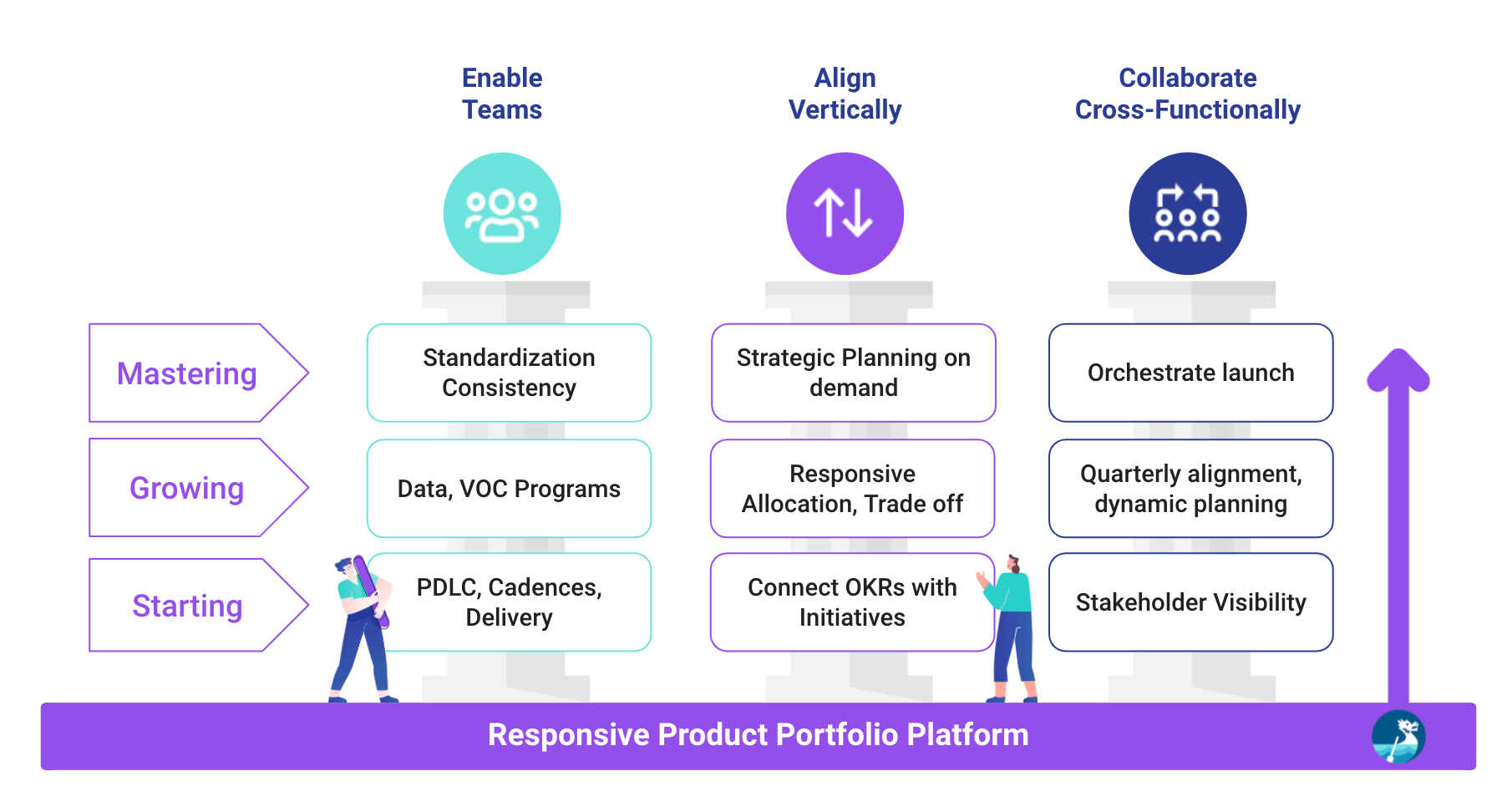As product-centric companies scale, misalignment, lack of visibility, dependency management, and communication overhead challenges rise exponentially.
This is precisely why in 2011, PayPal onboarded someone in the role of product operations for its Global Product and Experience organization. This newly invented role aimed to enable an effective product organization as it scaled. It has since invigorated and transformed the 400+ member product organization.
“(The role of product operations) drove cultural transformation for the ~400 person global Product organization to become a more disciplined, data driven team.”
Angela Song, VP Product Operations, PayPal
What’s the Mission of Product Operations?
The role of product operations (or product ops) or its mission is to enable an effective, outcome focused product organization, and broadly speaking, a product led company, to achieve the best portfolio outcomes.
What Does an Effective Product Organization Look Like?
- Clarity on strategy across all levels
- Responsive execution that delivers commitments
- Ability to scale without the business-damaging chaos
- Adoption of data informed decision making
- Balance of long term vision and short term outcomes to win in the current and future market
Why Should Product Ops Not Only Care About Product Outcomes, But Portfolio Outcomes?
As a company scales, there will be more product teams whose product managers will focus primarily on the goals and outcomes of their own areas. However, they often have to juggle between several goals, some from other teams. Product ops is the one who will shepherd team collaboration and planning so that these multiple product teams can work together effectively for the overall success of the company.
The best portfolio outcome is larger than the sum of individual team outcomes.
What Does Product Operations Do?
Product ops runs the strategic operations of a product organization and its responsibilities all tie directly to enabling an effective, outcome-focused product organization. You may think of Product Operations as the COO of a product org.
The responsibilities can be categorized in the following eight areas:
1. Evolve Product and Portfolio Processes and Tooling
The entire product organization runs on a product portfolio process, both for the product teams and for all stakeholders interacting with them. Setting the right foundation and adapting it responsively to changes is one of the most impactful areas of product operations.
This includes portfolio level planning and tracking, as well as product management and agile development process and tooling optimization, integration and best practices.
Therefore part of the role of product operations is to evaluate, own, and manage portfolio tooling to enable a single source of truth which can then be accessible to the entire company as appropriate. They’re the guardian of product portfolio management best practices for the entire product organization.
2. Lead Strategic and Portfolio Planning
Strategic Planning
Strategic operations start with aligning strategies at the executive level, along with relevant headcount, budget and allocation. This often is carried out as strategic planning. To facilitate this, product ops lead strategic offsites, quarterly planning, and OKR alignment with both product executives and product teams.
Portfolio Planning
In addition, product ops is proficient at applying product portfolio management best practices so that product leaders and teams can navigate and balance:
- Multiple goals
- Competing stakeholder and customer requests
- Prioritization best practices
- Short term OKRs and the long term product vision
One of the most important keys to product ops’ success in portfolio planning is managing dependencies since they stall 90% of product teams at some point. Product ops plays a key role in portfolio planning and collaboration to help identify, plan and track cross-team prioritization and dependencies. This often takes place during quarterly planning and sets up the portfolio for success.
90% of product teams have been stalled by dependencies.
3. Portfolio Visibility and Stakeholder Engagement
One of the most common challenges that product leaders face is effective stakeholder engagement. The role of product operations is pivotal in defining effective interaction and communication cadences through all levels of the organization, including with executive leadership, within product organizations, and with cross-functional teams e.g. sales, marketing, etc.
Product ops can strengthen visibility by implementing a PPM solution that serves as the single source of truth (for both planning and tracking), resulting in greater trust and transparency across the organization.
Read more about how to choose between a roadmap and PPM tool.
4. Customer and User Engagement
For individual product managers, it is often time consuming to collect user insights, correlate different data points, or try to recruit various customers/ target users for interviews and feedback sessions. Product operations helps to form processes around users and customer engagement, allowing product teams to be customer centric.
Product ops also helps define and evolve the engagement model and communication cadences between product and other teams that are customer facing such as support, sales, marketing, etc.
If a product org doesn’t have a user research team, product ops often takes on the task of helping product teams to recruit, manage user interviews or manage vendors for user research.
5. Product Analytics, Experimentation and Launch Planning
Analytics
In organizations where data may be scattered across various platforms or there is a need to work with dedicated data teams for reporting, product operations may help to standardize data definition. This way, they help ensure apple-to-apple consistency for values across systems. Product operations may aid in building and improving the data, access and definition processes for product teams.
Experimentation
Product ops may own the experimentation calendar to coordinate various product experiments and A/B tests. They can manage the planning holistically to ensure the quality of data and prevent conflicts.
Launch Planning
Product operations often acts as product’s liaison with the go-to-market team to define the timing and scope of various GTM plans and activities reflecting product delivery scope and schedule.
6. Financial / Headcount Planning and Tracking
In partnership with product leaders, finance teams, and vendors, many product ops teams are tasked with owning the product org’s budget, headcount, and financial planning and tracking.
Not only that but product ops executives often play a key role in advising product leaders on organizational design, career roadmapping, mentorship, training and other “people related” topics.
7. Product Tools and Vendor Management
As product-led companies grow and new product teams are added into the mix, it’s important that they build with the same toolset. When different teams all have their own tools for various tasks, it becomes increasingly complex to manage dependencies across the product portfolio. By standardizing the use of and processes related to tools team-wide, product teams can align easily. This, in turn, enables the successful execution of larger, cross-team initiatives that drastically move the needle.
Product operations coordinates tool evaluation for the product organization, collaborating with different users in the product teams, from understanding their needs to rolling out the solution. Common team tools include product portfolio management, design, user research, survey, analytics, collaboration tools, etc. Product operations reduces the burden of vendor evaluation, management, and pricing across the organization.
8. Operational Excellence
People Management
Product operations partners with product leadership and HR to create and maintain the product organization’s interview process, onboarding process, and product management training and coaching.
Templates
To increase consistency and efficiency, product operations partners with product leadership and product managers to create templates for product requirements, training, feedback collection, etc.
Where Does Product Operations Sit in a Product Organization?
Depending on the size of a product org, this role may be carried out as a shared responsibility by a product leader, a dedicated person or even a dedicated team.
Most often, the product ops team reports to the head of product. If there are several product operations team members, each might report to a different VP of Product who oversees a number of product managers.
In some larger organizations with hundreds of product managers, a VP of Product Ops may report to the CPO and own more comprehensive responsibilities such as:
- Strategic and portfolio planning
- Product analytics
- Experimentation
- Product GTM enablement
And in other cases, product operations reports to the CPTO (Chief Product and Technology Officer). In this reporting structure, they may also be more involved in the SDLC process and the respective tooling, including agile practices.
What Are the Top Wins of a Newly Created Product Operations Team?
Having read this far, you’ve seen by now just how broad the scope of product operations can be. With so much to do, it’s natural to wonder what a newly formed product ops team should focus on. The role is not yet mature and may look different from company to company, according to each one’s unique context.
However, for any growing, outcome focused product organization, product operations’ early efforts and quick wins should always correspond to its most pressing product challenges first:
Ensure Alignment on Goals (OKRs), Strategies, and Prioritization
- Implement a quarterly planning and portfolio roadmapping process
- Connect OKRs with product initiatives
- Facilitate healthy discussions about cross team allocation and tradeoffs
- Create and manage ongoing bi/weekly rhythm to review OKR and roadmap progress across product teams
Ensure Product Delivery to Commitment
- Create a source of truth planning and tracking system that introduces trust and transparency across the organization
- Establish a quarterly planning/ bi-weekly check in rhythm
Ensure Effective Stakeholder Engagement
- Incorporate feedback and requests in the product planning and communication process
- Build a scalable stakeholder engagement process with both meetings (real time) and tooling (async) interaction
Process is a product. Product Ops is the chief enabler of product teams where she leads and evolves the best practices of a product organization with her product management skills and operational chops.
The Roadmap to Success for Product Ops
As you continue the journey of building product ops, here is a roadmap to success which is centered around the three core pillars of the function: enabling teams, vertical alignment, and cross-functional collaboration.
Are you a product operations professional or thinking about becoming one? Share your tips and join the conversation in our Product Ops HQ community.




